
Nearly all monitoring systems have mobile apps, meaning that your system’s data is in the palm of your hand.
It is all too easy to set and forget your solar and monitoring systems. They work in the background, and most of the time, there are no problems or alerts that require your attention. However, it is important to regularly check-in on your systems, ensuring that the system is working correctly and efficiently and that your site’s energy usage remains consistent. The ability to see and visualise immediate energy usage helps in identifying equipment that may not appear at first glance to be a ‘high energy consumer’.
Recently, I have had the importance of monitoring my energy consumption demonstrated to me at my house. We have a pool with a pump set on a timer from 9 a.m. to 4 p.m. every day, taking advantage of our excess solar generation (battery storage coming soon). This has been working well since our solar system installation in late 2019. Below is my house’s typical energy usage when no-one is home in the day.
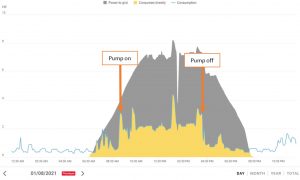
Last month, someone (not naming names) left the pool pump on manual overnight after using the manual pool vacuum, and the pump ran continuously for over 24 hours, consuming unnecessary energy (see picture below).
If someone were to have logged in and checked the house’s monitoring system that night, we could have easily prevented and rectified this situation.
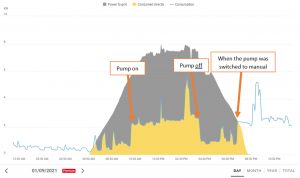
The following day was a fabulous sunny day and I wanted to see how much green, free electricity we’d generated and exported (not gloating I promise!). However, when I checked the monitoring system that evening, I noticed that the house’s consumption was abnormally high for that time of day. After a concerted family effort to check that nothing within the house was left on, we realised that the difference between current consumption and our average evening consumption was approximately the same as the pool pump. A quick walk to the shed proved us right with the pump going full speed at 9 p.m. After a little blame-game and then turning it off, our consumption quickly dropped back to normal.
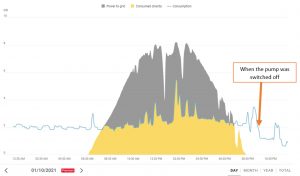
This little story helps to demonstrate that while most things usually operate in the desired manner, sometimes human error (ahem) or mechanical error can lead to unexpected energy usage so it’s worth creating a habit of checking on your system.
Additionally, monitoring acts as your ‘eyes on the roof’ – you can easily see whether your solar generation is sub-par or consistent. A decrease can suggest damage to the panels or fouling such as leaf debris or bird droppings. Checking your phone app every now and then sure beats having to climb on the roof to check.
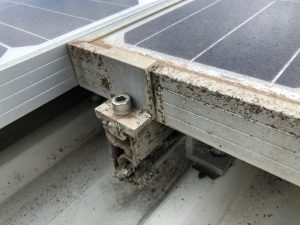
As energy consumers, we cannot become complacent.
Monitoring systems are often quite user-friendly, accessible, and have mobile apps, so your data is in the palm of your hand. Many inverters offer system monitoring apps – the screenshots above are from my Fronius inverter.
Another brand that offers monitoring from behind the switchboard (meaning you do not need a solar inverter) is Wattwatchers.
Wattwatchers is an Australian energy monitoring manufacturer and data platform. Their platform allows users to check-in on their site’s energy consumption, with the ability to separate circuits to simplify determining equipment energy consumption.
We are excited to offer the Wattwatchers monitoring system at a discounted price to small businesses, homes and schools.
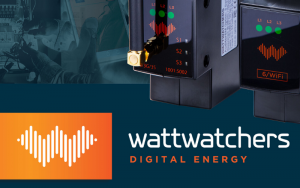
Small business and homes
$950 value for only $399+GST*. Suitable for solar and non-solar sites, Includes data and tools to help you optimise your electricity use. 3 year subscription also included (value $150).
* yes there’s always an asterisk! In this case, if you want more than 6 channels monitored or if it’s a complex installation then there may be additional costs.
Schools
Wattwatchers, in partnership with Solar Schools, is offering a grant-subsidised opportunity for 250 schools to partake in the My Energy Market. For $1,097 ex GST your school will get:
- 2x WattWatcher Devices (3×60 amp and 3×600 amp CT clamps)
- Installation subsidy of up to $700
- Ownership of your data
- Profile of how your school uses energy
- The ability to project data on public displays
- Energy Starter teaching resources
